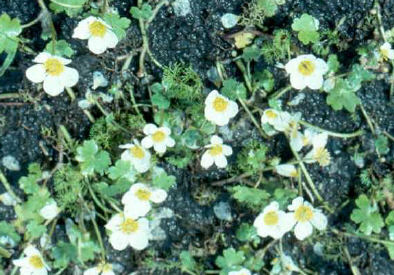IVY-LEAVED WATER-CROWFOOT (RANUNCULUS HEDERACEUS)
LOCAL BIODIVERSITY ACTION PLAN
Links to associated HAPs
Ponds
 Current Status
Current Status
The UK is thought to hold at least 20% of the global population of ivy-leaved water-crowfoot. Newton (1970) recorded ivy-leaved water-crowfoot as frequently occurring in Cheshire, in muddy margins of ponds and ditches, and spring heads.
The ivy-leaved water crowfoot was introduced to the Countdown programme in 1997. To date an LBAP Action Group is yet to be formed. Individuals or groups interested in being part of the pending action are welcome.
Threats
- Poor ditch management.
- Dredging.
- Infilling of ponds.
- Intensification of agriculture.
How are we helping to conserve Ivy-leaved Water-crowfoot in the Cheshire region?
- There is little current action aimed specifically at ivy-leaved water-crowfoot.
- Records are collected by the Cheshire Wildlife Trust and other groups, and are collated by the County Recorder.
Objectives, Targets and Actions
OBJECTIVES |
LOCAL TARGETS |
Increase awareness of the international importance of ivy-leaved water-crowfoot and safeguard known sites. |
Targets awaited |
ACTIONS REQUIRED |
- Form a Local BAP Action Group for the ivy-leaved water-crowfoot.
- Undertake survey work to establish current distribution.
- Determine specific threats.
- Raise awareness of the issues affecting ivy-leaved water-crowfoot.
- Promote appropriate management of ponds and ditches.
- Inclusion of species requirements into Local Environment Agency Plans .
|
Progress so far
| 1997 - 2006 Action Completed |
|
Contact details
References & Glossary
HMSO (1995): Biodiversity: The UK Steering Group Report, Volume 1: Meeting the Rio Challenge, London.
HMSO (1995): Biodiversity: The UK Steering Group Report, Volume 2:Action Plans, London.
Newton, A. (1971): Flora of Cheshire, Cheshire Community Council.
Newton, A. (1990): Supplement to Flora of Cheshire.


 Current Status
Current Status